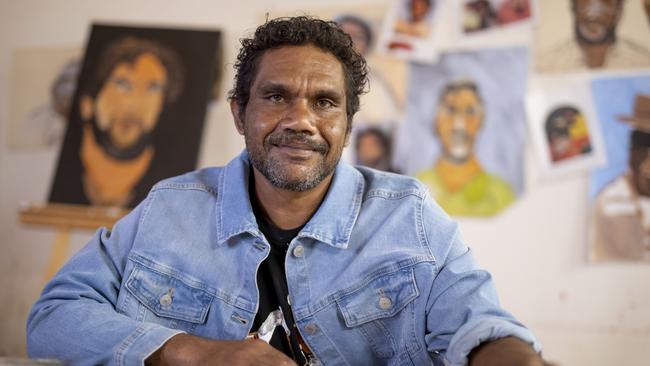Vincent Namatjira publishes children’s book about great-grandfather Albert
Vincent Namatjira says he wants young people to learn about the revered watercolour artist of Central Australia.

Albert Namatjira and his beloved watercolour landscapes of Central Australia – their full glory long obscured by restrictive copyright over his works – are coming back into circulation with two new books that celebrate his achievements and honour his troubled life.
Vincent Namatjira, Albert’s great-grandson and winner of last year’s Archibald Prize, will next week publish a children’s book about his famous forebear, featuring his own colourful paintings as illustrations.
And a new monograph, The Life and Times of Albert Namatjira, has recently been published by author Ken McGregor with more than 400 images of Namatjira’s paintings. Such a comprehensive book was made possible after copyright in his work was transferred to the Namatjira Legacy Trust in 2017.
Vincent Namatjira, 38, never knew his great-grandfather, who died in 1959, but has produced the book, called Albert Namatjira, so that more people can learn about him, his life, and his art.
“The reason I did a book is that I want people who don’t know Albert Namatjira to know Albert Namatjira,” he said. “This book is Albert’s story, but it is my illustration and my words.
“Mostly it’s for young ones, but it’s for anyone who wants to read.”
Many of Vincent’s paintings in the book were done in 2014 as a collection called Albert’s Story, which was acquired by the Queensland Art Gallery.
They include pictures of Albert Namatjira meeting the Queen, and a double portrait of Vincent with Albert as William Dargie depicted him in an Archibald-winning portrait.
“The paintings that you see in the book are my paintings, my technique, my way of art,” Vincent said. “For me, using my great-grandfather for this book is like paying respect.”
The book, published by Magabala Press, does not avoid the difficulties Albert experienced in life. After he was granted citizenship, he broke the law by supplying alcohol to other Aboriginal people and was sent to jail.
Vincent writes: “He was sad and ashamed. He had been living in two very different worlds – one as a famous, successful artist, and one as a Western Aranda man with cultural and family responsibilities … some say he died of a broken heart.”
Magabala publisher Rachel Bin Salleh said it was not unusual for children’s books to tackle sensitive subjects.
“I think it is important to be honest about our lives and our histories,” she said. “It helps to open the conversation to the bigger issues and it helps with our truer histories.”
Vincent, a father of three, said he hoped parents would buy the book for their children: “I did it because when I was young … I did not see books published by Indigenous people or illustrated by Indigenous people.”



To join the conversation, please log in. Don't have an account? Register
Join the conversation, you are commenting as Logout